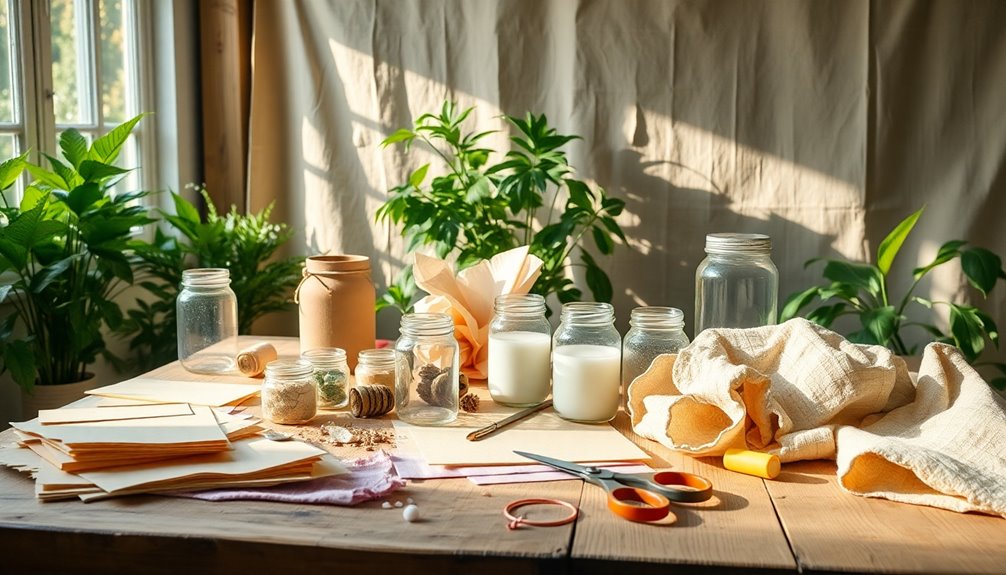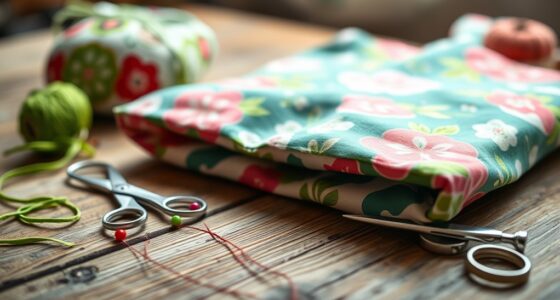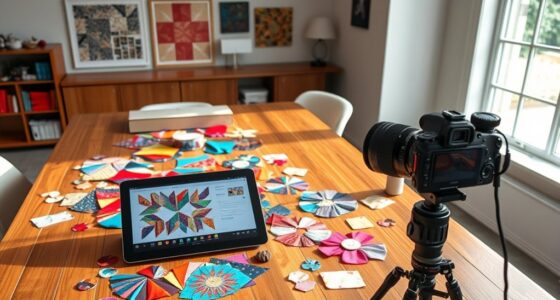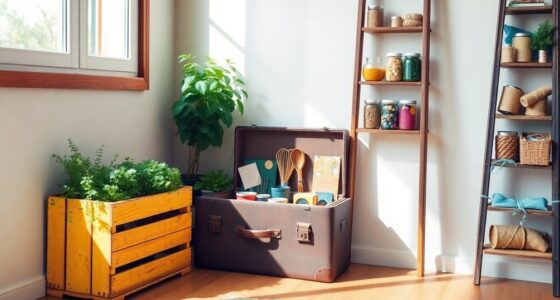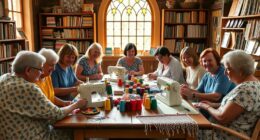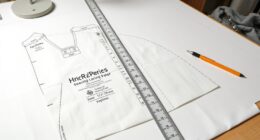Eco-friendly crafts let you express your creativity while making sustainable home projects. Start with recycled materials like glass jars or old clothes, and use non-toxic supplies like water-based paints. Follow simple step-by-step guides to bring your ideas to life, and involve your kids for added fun and learning. As you craft, focus on reducing waste and embracing upcycling. Keep going, and you'll discover more exciting eco-friendly projects that can transform your space sustainably.
Key Takeaways
- Start by gathering recycled materials like glass jars, cardboard, and old textiles for your eco-friendly projects.
- Use non-toxic, eco-friendly adhesives and paints to ensure a safe crafting environment.
- Follow detailed project instructions available online to guide your sustainable crafting efforts.
- Track your material usage to creatively minimize waste and incorporate remnants into new projects.
- Document your crafting process and share it on social media to inspire others and build a community around eco-friendly crafting.
Understanding Eco-Friendly Crafting
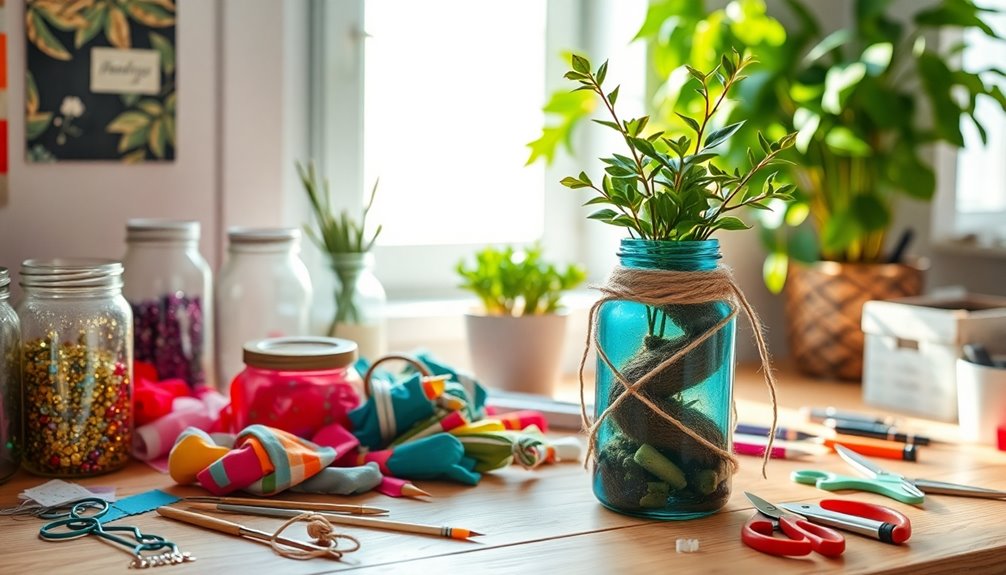
When you embrace eco-friendly crafting, you're not just creating art; you're making a positive impact on the environment. This approach focuses on using sustainable materials and techniques that minimize your ecological footprint.
By incorporating recycled materials and upcycling old items, you can greatly reduce waste and promote responsible consumption. Choosing non-toxic supplies like water-based paints and natural dyes guarantees your crafting journey remains healthy for both you and the planet.
Consider utilizing organic cotton or bamboo yarn, which supports responsible sourcing and fosters a circular economy. Additionally, using renewable energy innovations in your crafting space can further enhance sustainability efforts.
As you explore eco-friendly crafting, you'll enhance your creativity and innovation while deepening your connection to nature, making each project not only beautiful but also beneficial for the environment.
Benefits of Sustainable Craft Projects
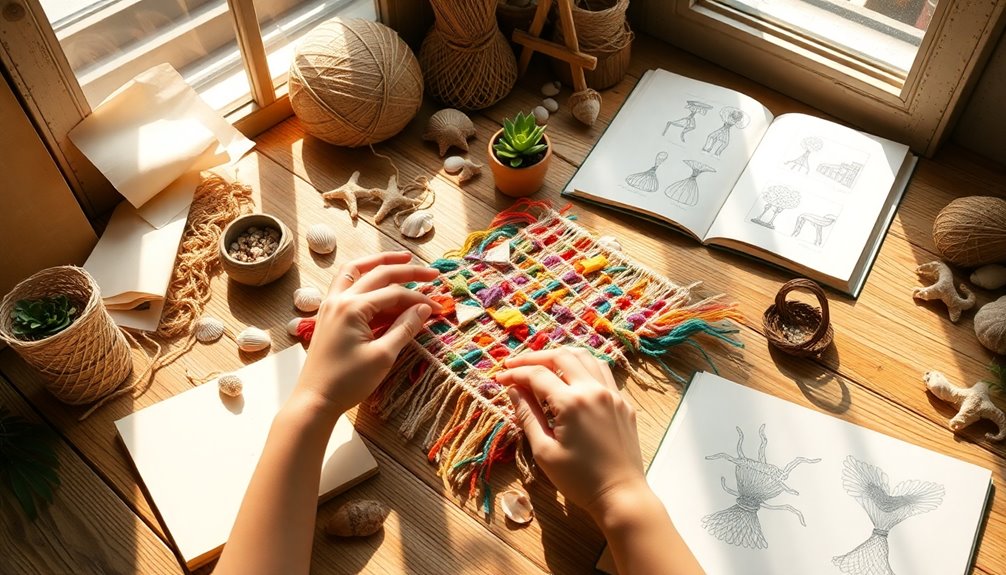
Sustainable craft projects can make a real difference in reducing waste and promoting a healthier planet. Not only do they cut down on landfill contributions, but they also save you money by using materials you already have. Additionally, incorporating eco-friendly materials into your projects can enhance their sustainability and appeal.
Environmental Impact Reduction
Crafting with eco-friendly materials not only sparks creativity but also plays a crucial role in reducing environmental impact.
By engaging in sustainable practices, you can help:
- Reduce landfill waste: Upcycling materials diverts an estimated 10 million tons of waste from landfills each year.
- Conserve natural resources: Recycling one ton of paper saves about 17 trees and 7,000 gallons of water.
- Lower greenhouse gas emissions: Creating one ton of recycled aluminum can save over 1,600 gallons of gasoline.
- Foster community connections: Participating in local crafting initiatives promotes environmental awareness and a sustainable lifestyle.
Additionally, implementing renewable energy sources in your crafting projects can further enhance sustainability and reduce your carbon footprint.
Cost-Effective Crafting Solutions
Eco-friendly craft projects offer a budget-friendly way to release your creativity while being kind to the planet. By embracing sustainable crafting, you can turn everyday items into unique treasures.
Recycle glass jars or old fabrics to create functional and decorative pieces without spending a fortune. This practice not only saves money but also helps minimize waste by replacing disposable items with reusable alternatives like cloth napkins and shopping bags.
Many DIY projects require minimal investment in tools and supplies, allowing you to utilize what's readily available at home. Upcycling fosters a circular economy, reducing the demand for new products.
Selecting Recycled and Natural Materials
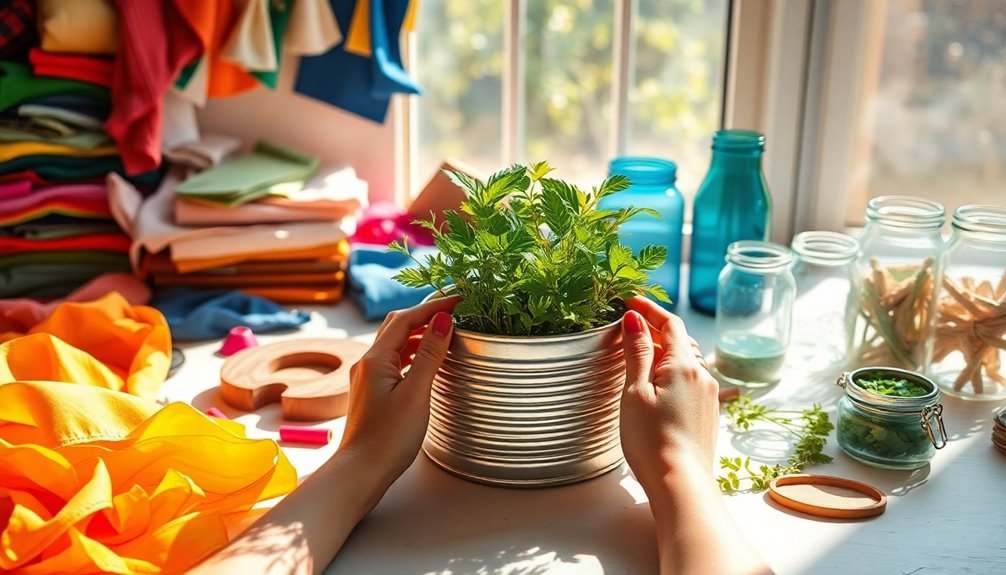
- Recycled Materials: Use glass jars, cardboard, and old textiles that can be easily repurposed.
- Natural Materials: Opt for bamboo, jute, and organic cotton, which are sustainable options with lower environmental impacts.
- Eco-Friendly Craft Supplies: Look for items with minimal packaging to reduce waste and promote responsible consumption.
- Upcycled Items: Visit local thrift stores or community swaps for secondhand treasures that support a circular economy.
Incorporating vintage furniture into your projects can enhance the farmhouse aesthetic while promoting sustainability.
Step-by-Step Guide to Creating Eco-Friendly Crafts
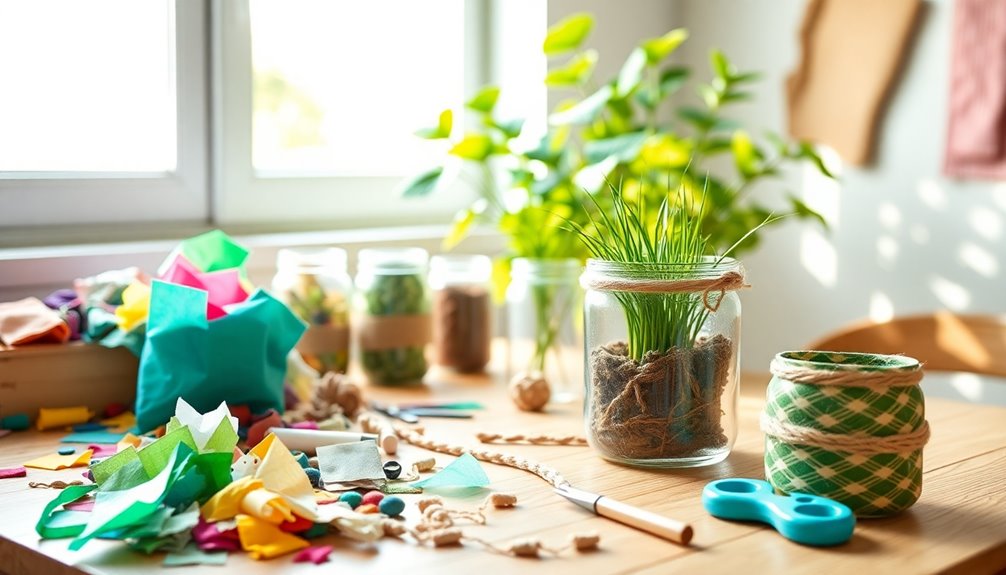
Choosing the right materials sets the stage for your crafting journey.
Begin by gathering old scrap materials from your home, like glass jars, cardboard, or fabric. These will serve as the foundation for your eco-friendly projects.
Use eco-friendly adhesives and paints to guarantee your crafting remains safe for the environment.
Follow detailed instructions for popular projects, such as repurposed tote bags or natural leaf printing, to boost your skills.
Track your material usage and minimize waste by creatively incorporating remnants into new designs.
Document your process and completed projects to inspire others in your community towards sustainable products and practices. Additionally, consider integrating foraging baskets into your crafting to create functional and eco-friendly storage solutions.
Creative Upcycling Ideas for Home Projects
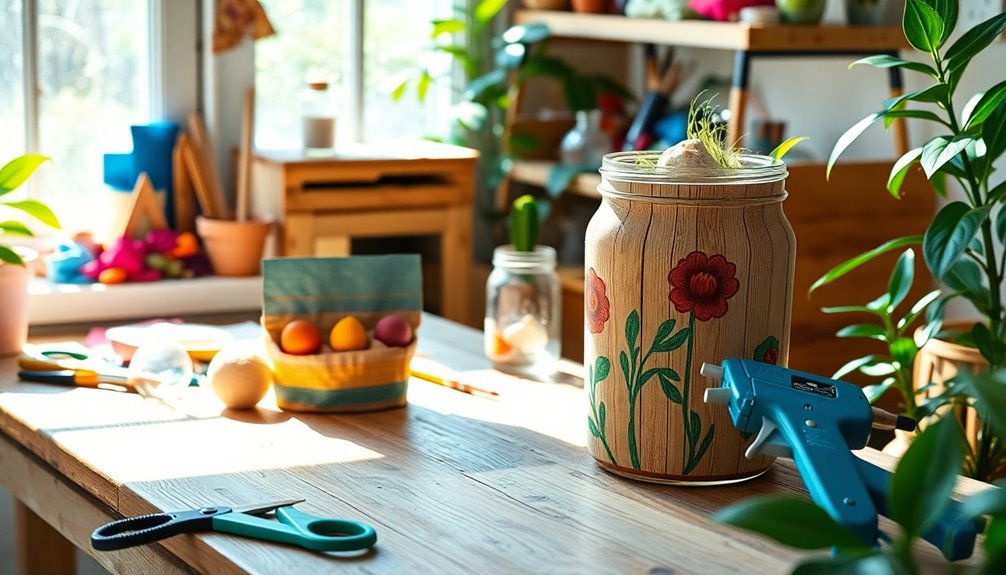
Transforming everyday items into unique home decor not only sparks your creativity but also helps reduce waste. By repurposing objects like glass jars into stylish vases or old t-shirts into colorful throw pillows, you can infuse your living space with personal flair. Moreover, these projects can become fun bonding activities with family and friends, inspiring everyone to think outside the box. To get started, consider checking out a seasonal holiday decoration tutorial that guides you through creating beautiful, eco-friendly decor pieces for your home.
Upcycling is a fantastic way to create sustainable crafts while giving new life to scrap materials. Here are some creative project ideas you can try:
- Old Glass Jars: Turn them into stylish storage containers or decorative candle holders.
- Wooden Pallets: Craft them into rustic furniture pieces, like coffee tables or garden benches.
- Fabric Scraps: Use them to sew patchwork pillows or tote bags, effectively reducing textile waste.
- Tin Cans: Transform them into decorative planters for your indoor or outdoor spaces.
Additionally, being aware of early detection can encourage individuals to take proactive steps in their health, just as upcycling encourages sustainable practices.
Engaging Children in Sustainable Crafting
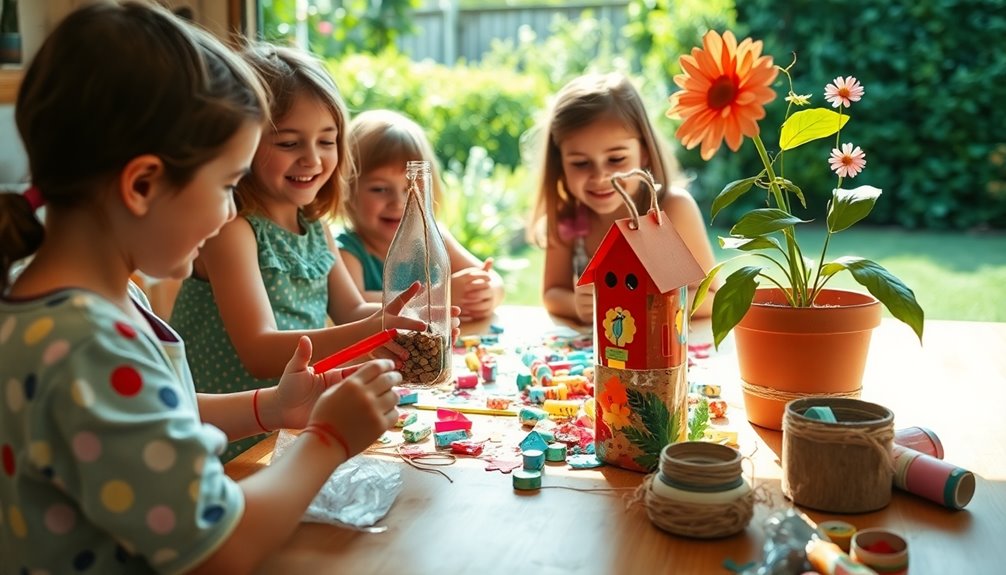
Engaging your kids in sustainable crafting transforms playtime into valuable learning experiences. As they create with recycled materials, they'll not only boost their creativity but also understand the importance of environmental responsibility. Together, you can build a stronger awareness of sustainability while having fun with hands-on projects. This approach to crafting can also encourage creativity and imagination in children, fostering skills that are beneficial in many aspects of their development.
Learning Through Creative Play
How can you turn everyday waste into fun, creative projects that not only entertain but also teach important lessons about sustainability? Engaging children in eco-friendly craft projects emphasizes the importance of recycling while fostering their creativity.
Here are some ideas to get started:
- Transform old clothes into tote bags using scrap fabric.
- Create unique paper bead jewelry from recycled paper.
- Make natural leaf prints using leaves and eco-friendly paint.
- Collaborate on a cardboard box dollhouse to encourage teamwork.
These activities not only promote learning through creative play but also instill values of environmental stewardship. Additionally, Waldorf toys encourage imaginative play, making crafting a wonderful complement to their developmental benefits.
As kids craft, they'll feel accomplished seeing their creations evolve from waste into meaningful items, nurturing habits that benefit our planet.
Building Environmental Awareness Together
Crafting offers a fantastic opportunity to not only express creativity but also build environmental awareness together. By engaging children in sustainable crafting, you teach them the importance of repurposing materials, which reduces waste and supports a circular economy.
Hands-on activities, like leaf printing or making bird feeders, help kids connect with nature and understand their role in preserving it. Community workshops focused on eco-friendly practices foster teamwork and collaboration, instilling a sense of responsibility for collective stewardship.
Introducing non-toxic supplies promotes healthier lifestyles and a greater respect for the planet. As you craft together, you're not just creating art; you're nurturing future eco-conscious citizens who care about their environment. Additionally, these activities can be a great way to discuss financial considerations for elderly care, as they promote awareness of resourcefulness and sustainability in all aspects of life.
Tips for Reducing Waste While Crafting
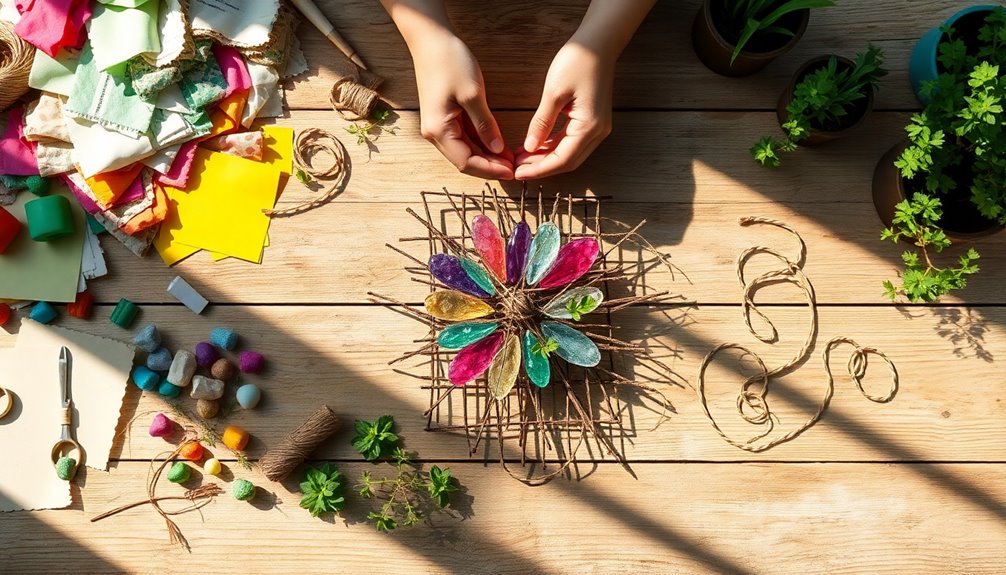
As you commence your next creative project, planning ahead can greatly reduce waste and keep your crafting journey eco-friendly. Here are some tips to help you along the way:
- Make a List: Outline the materials you need to avoid impulse buys and reduce waste from unused supplies.
- Use Scrap Materials: Repurpose fabric remnants or leftover paper from previous projects to create stunning new items.
- Opt for Eco-Friendly Supplies: Choose natural adhesives and paints that are biodegradable to lessen harmful energy consumption impacts.
- Set Up a Crafting Station: Collect reusable items, like jars or cardboard, which can be utilized in future crafting projects.
- Incorporating eco-friendly materials into your crafting can significantly enhance the sustainability of your projects.
Sharing Your Eco-Friendly Creations
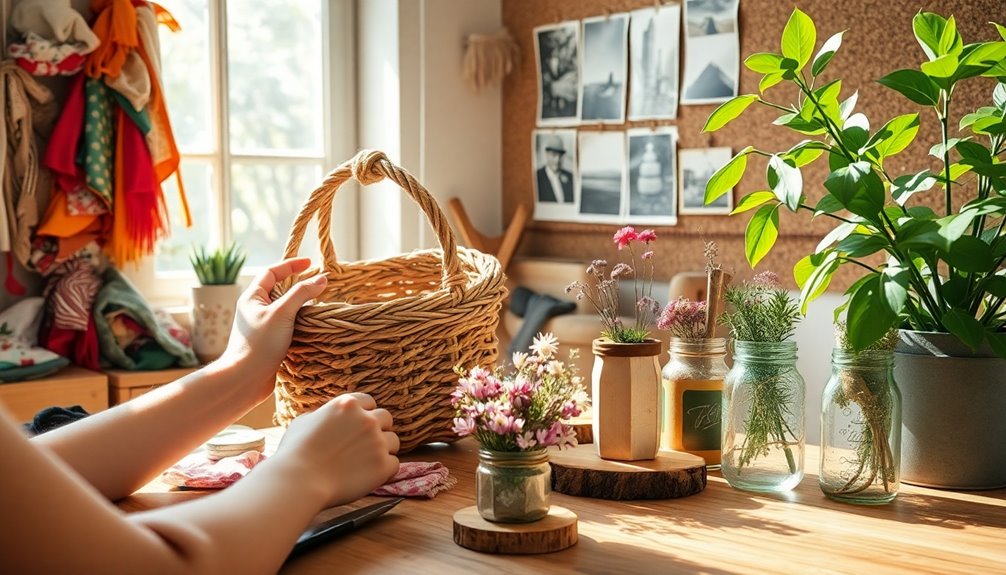
Sharing your eco-friendly creations not only showcases your talent but also encourages others to embrace sustainable crafting. By documenting your process and using scrap materials, you can inspire a community focused on conserving resources. Utilize social media and hashtags like #EcoFriendlyCrafts to connect with like-minded individuals. Participating in local craft fairs lets you share project ideas and support local initiatives. Consider creating a blog to serve as a resource for others seeking guidance on eco-friendly crafts.
| Platform | Benefits | Tips |
|---|---|---|
| Social Media | Inspire and connect | Use relevant hashtags |
| Local Craft Fairs | Engage with your community | Display your projects |
| Blogs | Share knowledge and ideas | Offer tutorials |
Frequently Asked Questions
What Are Some Eco-Friendly Crafting Tools I Can Use?
When you're looking for eco-friendly crafting tools, consider using bamboo scissors, which are sustainable and durable.
You can also opt for recycled paper and biodegradable glues to minimize waste. Natural fiber paintbrushes and organic cotton fabrics are great choices too.
Don't forget about using non-toxic paints and dyes made from plant-based materials.
How Can I Properly Dispose of Non-Recyclable Craft Materials?
Imagine a craft box overflowing with vibrant materials, but not all can be recycled.
To properly dispose of non-recyclable craft items, check local disposal guidelines to see if there are specific drop-off locations. You can also consider reusing or repurposing these materials in other projects.
If they're truly unusable, bag them securely and throw them in the trash, ensuring they don't end up contaminating recyclable streams.
Can I Sell My Eco-Friendly Crafts Commercially?
Yes, you can sell your eco-friendly crafts commercially!
Start by researching local regulations and permits required for selling handmade goods.
Establish an online presence through social media or a website to showcase your creations.
Consider local markets or craft fairs to reach customers directly.
Focus on your unique selling points, like sustainability and creativity, to attract buyers.
Don't forget to engage with your audience and build a community around your eco-friendly brand!
What Are Some Beginner-Friendly Eco-Friendly Craft Projects?
When it comes to crafting, it's often true that "many hands make light work."
For beginner-friendly eco-friendly projects, you can start with simple items like repurposed paper beads or upcycled t-shirt bags.
Try making natural dye from vegetables or creating seed bombs using compost and wildflower seeds.
These projects not only spark creativity but also help you understand sustainability.
You'll find joy in making something beautiful while being kind to the planet!
How Do I Maintain My Eco-Friendly Crafts Over Time?
To maintain your eco-friendly crafts over time, you'll want to start by cleaning them gently with natural cleaners.
Avoid harsh chemicals that can damage materials. Regularly check for wear or damage, and make repairs as needed using sustainable methods.
Store your crafts in a cool, dry place to prevent deterioration. You can also reapply finishes like beeswax or natural oils to keep them looking fresh and vibrant.
Enjoy your sustainable creations!
Conclusion
As you weave your eco-friendly creations, think of each project as a seed planted in a garden of sustainability. By nurturing your creativity with recycled materials, you're not just crafting; you're cultivating a greener future. Each piece you make symbolizes a commitment to the planet, inspiring others to join the movement. So, let your imagination bloom, share your art, and watch as a community of eco-conscious creators blossoms around you. Together, we can craft a sustainable world!
